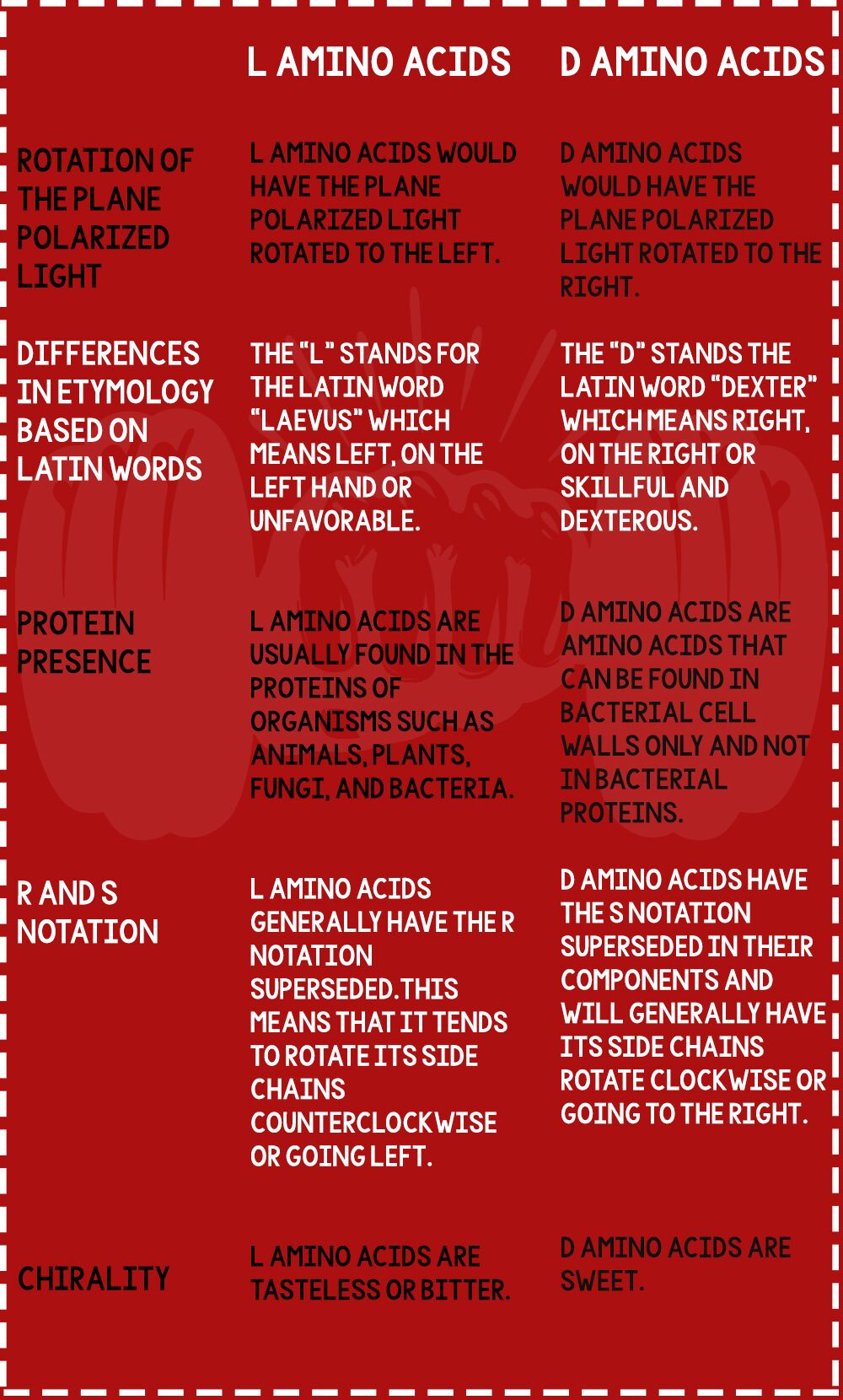
Proteins help develop and enhance muscle growth and development and as such, is very important in making the human anatomy sound and functional. The building blocks of protein are called amino acids and these amino acids are in the human body, the foods we consume, and in nature herself. However, there are key differences between the various types and classifications of amino acids. One such distinction would be between L Amino acids and D amino acids. In this article, we shall look at the differences between L vs. D Amino Acids.
What are L Amino Acids?
L Amino Acids are “the” amino acids considered the main building block of proteins. These proteins are considered essential in maintaining the integrity of the cell and as such, was thought of as significantly important in the evolution of life.
L Amino acids are called such due to the position of their R or side chain which is on the left side. These amino acids occur in all the proteins of life forms such as animals, plants, fungi and even bacteria.
L Amino acids have distinct and structural functions within the organisms’ cells. They serve as enzymes that initiate biochemical reactions. They also help regulate the biological functions of other more advanced organisms such as humans and other mammals.
An interesting side note is that these L Amino acids are the same amino acids produced during lightning. Ultimately, L Amino Acids have their amine group occurring to the left.
What are D Amino Acids?
D Amino acids on the other hand, are amino acids that have their side chain occuring on the right side. The letter “D” in D Amino Acid actually came from the latin word “dexter” which means right.
These Amino acids are generally not produced and incorporated into proteins by organisms. While D Amino Acids may have been found in bacterial Walls, they were not found in bacterial protein. Because of this, scientists in the past dismissed D Amino acids as having little impact on the various biological processes. Recent studies have suggested though, that D Amino Acids play a role in key biological functions of organisms such as overall brain function in connection with learning, memory and behavior.
L vs. D Amino Acids: What are the Main Differences?
There are a number of key differences between L Amino Acids and D Amino Acids. Below are some of these differences:
-
Rotation of the Plane Polarized Light
The rotation of this plane generally determines what type of amino acid a certain amino would be. L Amino acids would have the plane polarized light rotated to the left while D amino acids would have the plane polarized light rotated to the right. These differences can also be likened to the human hands where there is a mirror image for both right and left hands. In short, L Amino acids have their side chains rotated counterclockwise while R amino acids have their side chains rotated clockwise.
-
Differences in Etymology based on Latin Words
The L stands for “Left” or “Laevus”, which means left, on the left hand, or unfavorable. Meanwhile, D stands for “Dexter” which means right, on the right or skillful and dexterous in Latin.
-
Protein Presence
As stated earlier, L Amino acids are usually in the proteins of organisms such as animals,plants, fungi and bacteria. D Amino acids, on the other hand, are amino acids that can be found in bacterial cell walls only and not in bacterial proteins.There is evidence then to suggest that L-Amino acids are directly manufactured in cells and eventually incorporated into proteins
-
R and S Notation
R and S notations are also one of the main differences between L and D Amino Acids. L Amino acids generally have the R notation superseded while D amino acids have the S notation superseded in their components. This means that with the R notation superseded or set aside, L amino acids do tend to rotate its side chains counterclockwise or going left. D Amino acids having the S notation superseded or set aside, will generally have its side chains rotate clockwise or going to the right.
-
Chirality
Amino acids, except Glycine, have chiral cores and these cores can have certain chiral properties unique for each group of L and D Amino acids. Chirality can then be identified and used for determining the chirality of L and D Amino acids. It is generally accepted that L Amino acids are tasteless or bitter while D Amino acids are sweet
The Importance of Both L and D Amino Acids
Both L and D Amino acids are vital in the proper functioning of the human body. Some might argue that L amino acids are more important because of its direct link of protein and muscle growth and development. But there is unquestionably hard data to prove that both L and D acids are important for human survival.
L amino acids are indeed very important in the development of muscle fiber and tissue. It also aids in the different hormonal and biological functions of the body. Its influence on the protein content of the human body makes it an integral part of growth and development, physical growth and mental wellness.
D amino acids, on the other hand, may have a less varied role compared to L amino acids. They are not directly involved in an organism’s production of protein. However, D amino acids play a crucial role in the enhancement of the brain’s functions such as memory, behavior, and learning.
These two (2) groups of amino acids. L Amino focuses on the more general workings of the human body through protein and muscle development. The other is D Amino that centers on the mental and brain functions of an individual. When combined, they give human beings a complete and functional source of molecular components capable of ensuring the health, wellness and improved quality of life.
